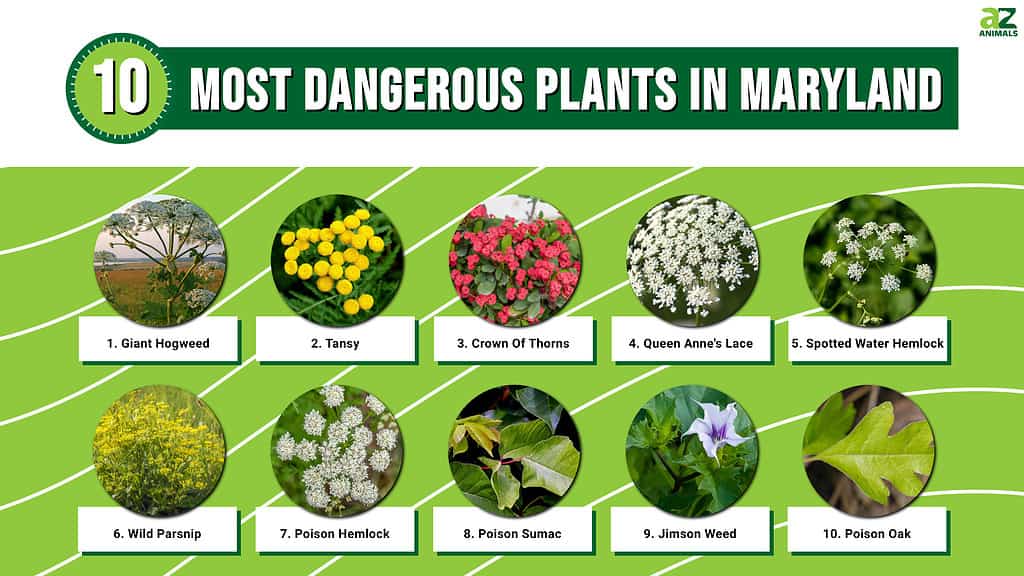
The most dangerous plants in Maryland are often the most innocuous, with a few exceptions. Since grade school, kids have been warned against poison ivy, oak, and sumac. “Leaves of three, let it be” is a mantra every fifth grader should know.
However, most grown adults couldn’t identify any poisonous three immediately. There are many plants in Maryland (outside of poison ivy, oak, and sumac) that outdoor enthusiasts in the state should be aware of.
Most of them are a temporary sort of danger, such as causing itchy rashes or painful blisters. However, some plants are dangerous enough that they can cause blindness and should be recognizable to you and avoided at all costs. This is especially true if you have kids that love to play outdoors.
1. Giant Hogweed (Heracleum Mantegazzianum)
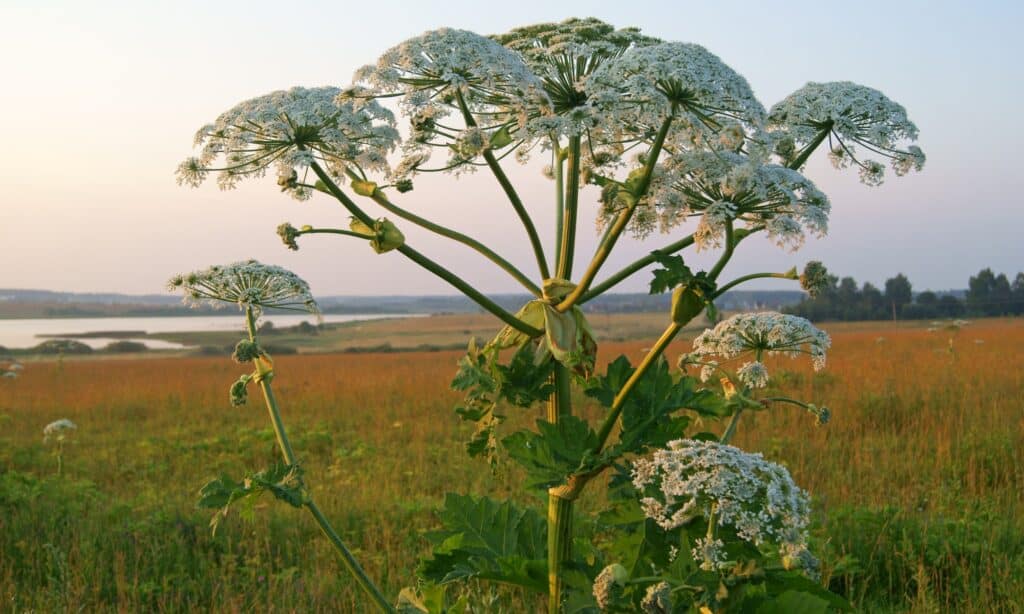
According to a CBS Baltimore report
, giant hogweed sap causes painful blisters and can even leave behind permanent scarring once the body heals.
©iStock.com/hapelena
Giant hogweed is number one because it is probably the single most dangerous plant in Maryland. While the giant hogweed has always been known for causing painful blisters that proliferate one or two days after contact, it’s much worse than that.
According to a CBS Baltimore report, giant hogweed sap causes painful blisters and can even leave behind permanent scarring once the body heals. However, the fact that the skin doesn’t react immediately is what makes this plant so dangerous.
Touching it is enough to transfer some of the dangerous sap to your fingertips. If you happen to scratch your eye, or both eyes, blindness may result. The stuff can grow up to 14′ high and a close-up encounter, face-to-face, may not end up well for you.
2. Tansy (Tanacetum Vulgare)
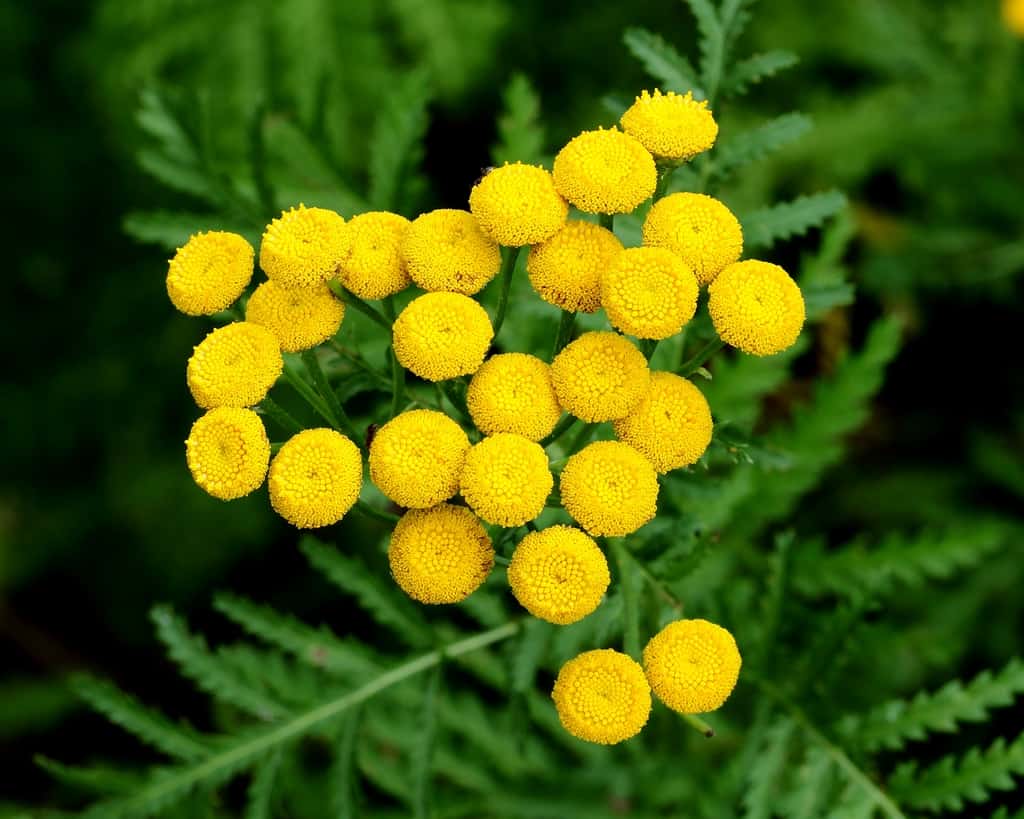
It does have medicinal properties that supposedly rid the body of intestinal worms.
©Dominicus Johannes Bergsma / CC BY-SA 4.0, via Wikimedia Commons – Original / License
Tansy isn’t dangerous to touch but it is dangerous to consume. Consuming this plant is known to cause upset stomach, painful inflammation in the bowels, and convulsions (the latter being the worst-case scenario). Under normal circumstances, it’s easy to assume that people wouldn’t eat random plants found outside.
However, Tansy does have medicinal properties that supposedly rid the body of intestinal worms. The problem is, most people don’t know how to prepare it or simply consume too much of it. More and more people are turning to natural remedies, growing herbs in their gardens, or tracking down plants.
It’s essential to understand the uses and drawbacks of consuming tansy and how best to prepare it before consuming even a small amount. Tansy is instantly recognizable thanks to its tiny clusters of yellow, button-like flowers.
3. Crown Of Thorns (Euphorbia Milii)

As with the giant hogweed, accidentally getting the sap in your eyes can cause blindness, though the effect is temporary.
©iStock.com/Rawf8
The crown of thorns is a pretty, flowering plant, despite making our list of the most dangerous plants in Maryland. A lot of people keep crowns of thorns in their homes precisely because they are a beautiful, slightly exotic-looking plant.
Unfortunately, the crown of thorns releases a milky, sap-like substance that causes blisters, rashes, inflammation, and itchy skin. As with the giant hogweed, accidentally getting the sap in your eyes can cause blindness, though the effect is temporary, especially if you are quick to rinse out your eyes.
This same milky sap is also dangerous to animals and, most importantly, pets. Ingesting the plant will cause indigestion, stomach cramps, and possibly diarrhea and/or vomiting. If you have this pretty plant in your household, handle it carefully and keep it out of reach of pets.
4. Queen Anne’s Lace (Daucus Carota)

It is capable of causing nasty burn rashes, dermatitis, and blisters.
©Antho B/Shutterstock.com
Queen Anne’s Lace is an invasive plant in the United States. The plant is native to Asia and Europe, brought over by the original colonists as a medicinal plant. Fortunately, it does have medicinal properties. Unfortunately, most people run into Queen Anne’s lace on accident, not looking for a natural, medicinal alternative.
It is capable of causing nasty burn rashes, dermatitis, and blisters. The good news is that it mostly only affects those with sensitive skin or those who have to deal with eczema. Another problem with this plant is how similar it is to other plants, some of which are poisonous and some of which are not.
For instance, Queen Anne’s lace strongly resembles cow parsnip and spotted water hemlock. Queen Anne’s lace also grows like a weed, quickly taking over areas close to water. The plant grows to about three feet in height (maximum), so it’s plenty tall enough to brush up against your hands and arms.
5. Spotted Water Hemlock (Cicuta Maculata)
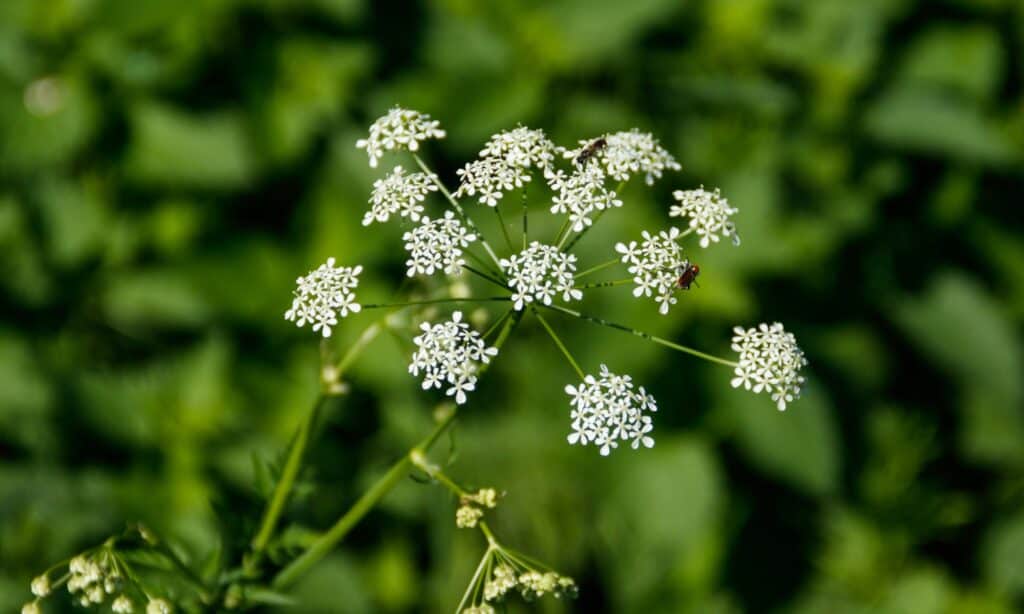
Spotted water hemlock is very poisonous to both people and pets (animals of all kinds really, but especially pets).
©iStock.com/OlyaSolodenko
Another weed-like plant—and one that highly resembles Queen Anne’s Lace—spotted water hemlock is fairly widespread in the state of Maryland. While it certainly belongs on the most dangerous plants in Maryland list, spotted water hemlock often finds itself on the “most deadly plants in the US” list as well.
That’s a pretty frightening statement, especially because it’s a fairly prevalent plant. Spotted water hemlock is very poisonous to both people and pets (animals of all kinds really, but especially pets).
Ingesting spotted water hemlock causes all kinds of abdominal chaos, including up to full-fledged seizures and delirium. Sometimes, it’s bad enough to cause death. It’s often either confused for a different plant, resulting in trouble for humans, or consumed by pets, especially dogs.
6. Wild Parsnip (Pastinaca Sativa)

Dermatitis, skin irritation (from light to moderate), rashes, and even blistering can occur when coming into contact with wild parsnip.
©iStock.com/RuudMorijn
Wild parsnip resembles Queen Anne’s lace and spotted water hemlock, however, its flowers are yellow instead of white. Also, like Queen Anne’s lace, wild parsnip is native to Asia and Europe and was brought over to America during the days of colony establishment.
Dermatitis, skin irritation (from light to moderate), rashes, and even blistering can occur when coming into contact with wild parsnip. It can grow between two and five feet tall, so it’s more than tall enough to rub up against your upper body, arms, and hands.
While it’s dangerous in terms of facilitating skin irritations, it’s not nearly as deadly as spotted water hemlock. However, ingesting it raw or in large quantities will cause stomach discomfort, bloating, cramps, and other, uncomfortable stomach issues.
7. Poison Hemlock (Conium Maculatum)
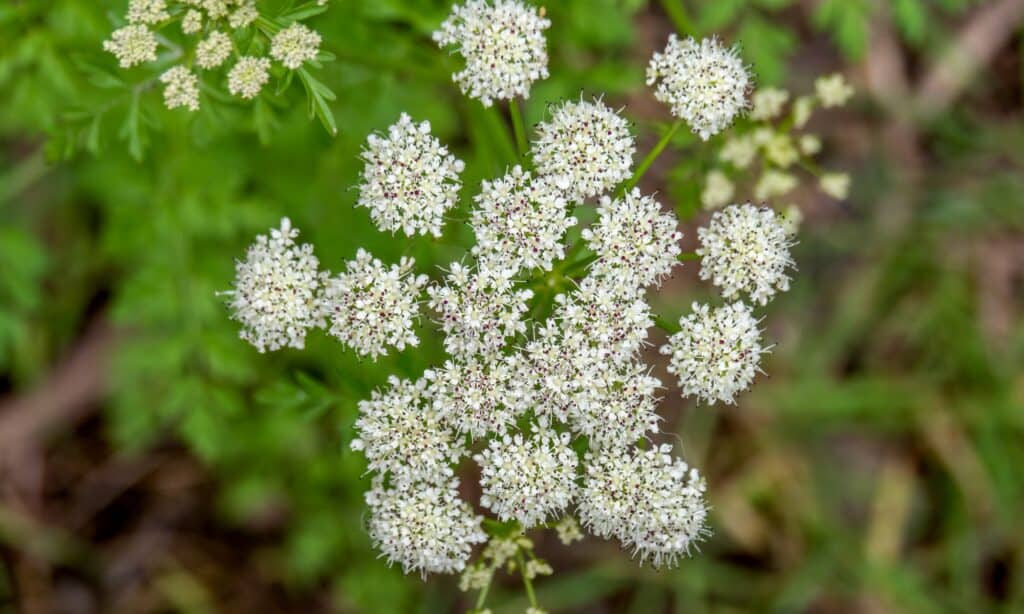
While it doesn’t cause the kind of rashes and inflammation that some of the other plants on this list cause, it’s deadly when consumed.
©iStock.com/Goldfinch4ever
One of the few “most dangerous plants in Maryland” on our list that comes with a prewarning in the name of the plant. Poison hemlock is indeed poisonous. It highly resembles Queen Anne’s lace and spotted water hemlock. So, if you have those plants in mind, you’ll be able to recognize and be wary of poison hemlock.
The plant is native to Asia, Europe, and Africa and, like the above-listed plants, was brought to North America during colonial times. The plant can reach eight feet in height or remain relatively short, at three feet.
While it doesn’t cause the kind of rashes and inflammation that some of the other plants on this list cause, it’s deadly when consumed. This is true even if you only consume a very small amount. For pets, such as dogs and cats, even a small amount will likely be enough to kill.
8. Poison Sumac (Toxicodendron Vernix)
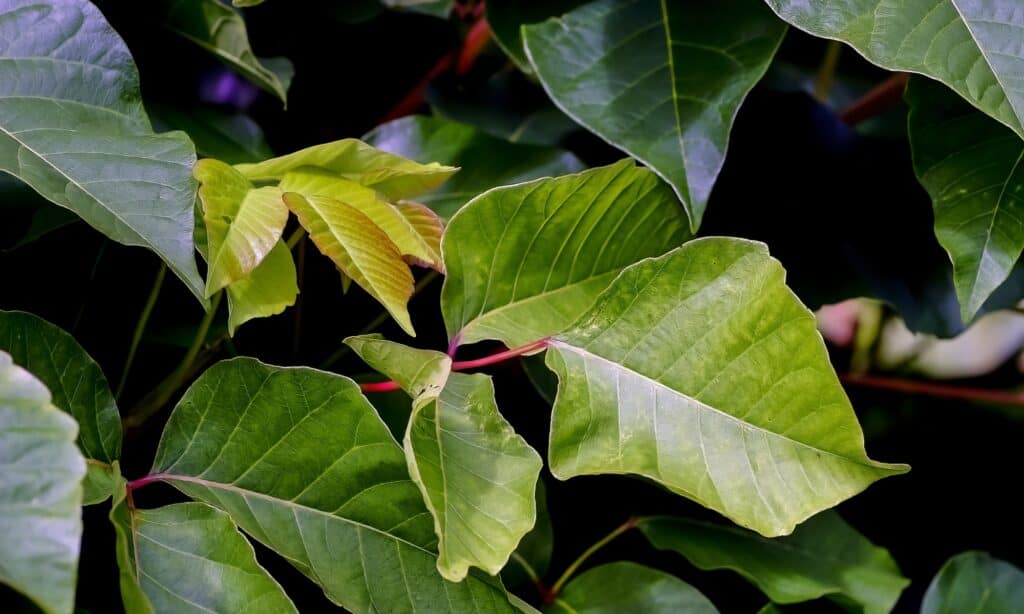
It looks sort of like a fern but with large, reddish, upside-down cones projecting from the sea of leaves.
©iStock.com/Werner Meidinger
Poison sumac is probably the nastiest of the poisonous three—oak, ivy, and sumac—and is capable of causing severe skin reactions even from the briefest contact. In Maryland, sumac is typically found in low-lying areas and anywhere near water or swamps.
It looks sort of like a fern but with large, reddish, upside-down cones projecting from the sea of leaves. urushiol is the name of the resin that seeps from the plant and it’s very potent. You can even get sick from inhaling the fumes from the sap, nearby the plant.
Getting the resin on your skin will often cause rashes, inflammation, and blisters. Worse yet, scratching or rubbing the rash and touching it somewhere else on your body will effectively spread it around, creating new rashes and inflammation.
9. Jimson Weed (Datura Stramonium)
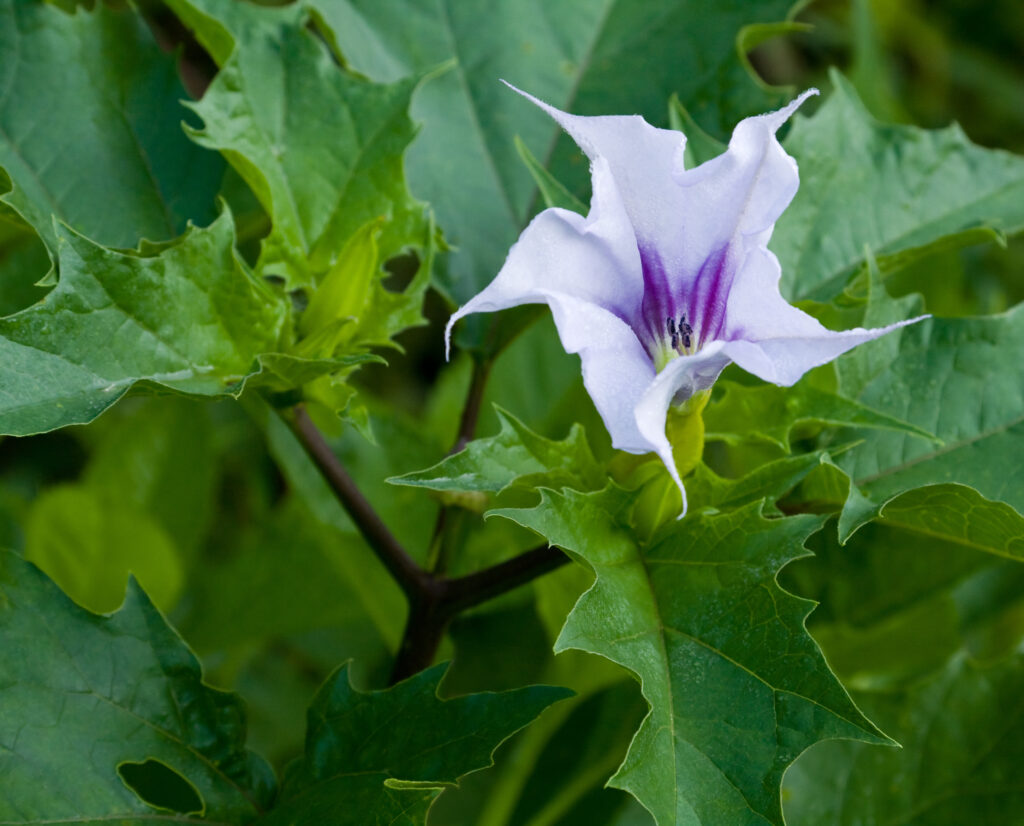
Jimson Weed overwhelmingly grows in agricultural spaces throughout the state of Maryland, thriving on the more fertile soil.
©Melinda Fawver/Shutterstock.com
Also known as devil’s snare, devil’s trumpet, and thorn apple, jimson weed is one of the most dangerous plants in Maryland. The problem is, it’s quite a pretty plant as well—pretty enough that it might lure in smaller children who want to pick the pretty, large, white flowers.
Jimson Weed overwhelmingly grows in agricultural spaces throughout the state of Maryland, thriving on the more fertile soil. Alkaloids hyoscyamine and atropine are the primary culprits with Jimson weed and they cause problems whether they are ingested or come into contact with your skin.
Rapid heart rate, severe nausea, stomach cramps, and even delirium are common side effects of ingesting Jimson weed. On the skin, it causes rashes, inflammation, and severe itching. Though it may produce large, pretty flowers, it’s highly advisable to avoid it at all costs.
10. Poison Oak (Toxicodendron Pubescens)
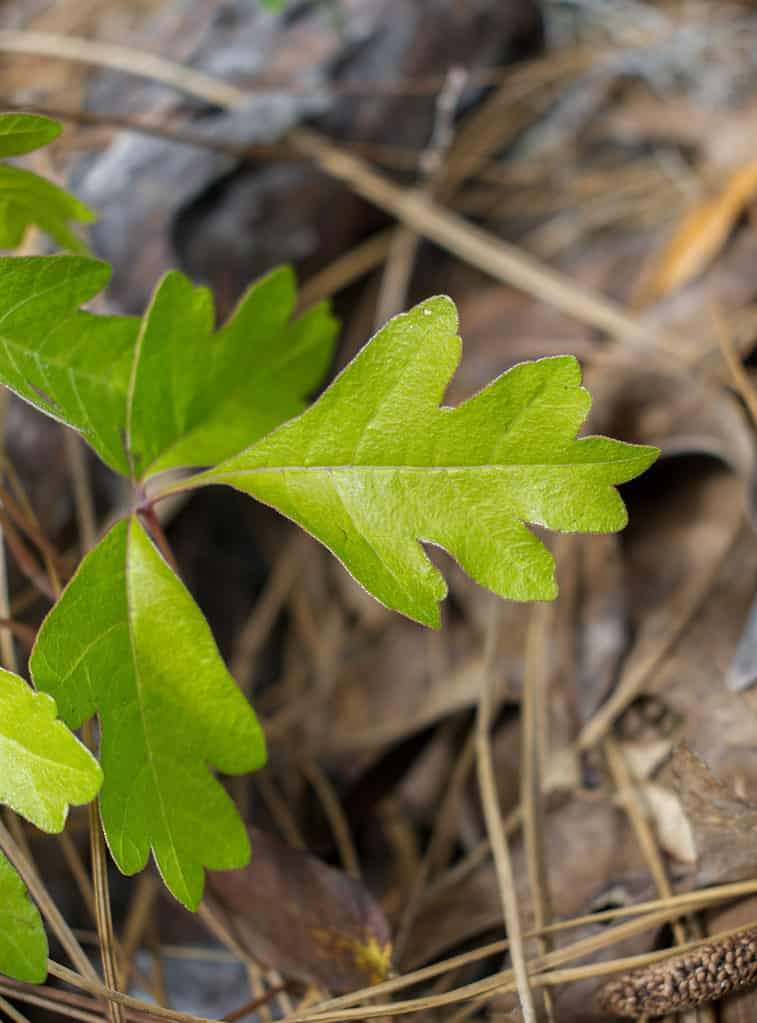
Touching poison oak, even very lightly, is enough to bring on intense, dermatological reactions.
©iStock.com/Dan Rieck
There are two types of poison oak, the above Toxicodendron Pubescens, and the Toxicodendron Diversolobum. The former is the Atlantic poison oak and the latter is the Pacific poison oak. Maryland, by its location, only has to deal with the Atlantic version, which is quite enough on its own without adding in the Pacific variation.
Touching poison oak, even very lightly, is enough to bring on intense, dermatological reactions. Severe itching, inflammation, red skin, rapid spread (whatever you touch after scratching it becomes affected as well), and potential infections are all commonplace when coming into contact with poison oak.
The leaves of the poison oak plant grow in threes, are medium-sized, and are shaped like diamonds, with slightly rounded angles. The leaves are often very glossy in appearance. Not to the level of Holly but pretty close nonetheless.
Final Thoughts On The 10 Most Dangerous Plants In Maryland
These ten most dangerous plants in Maryland are capable of causing severe discomfort and, possibly, death. This is mostly true if some of the plants are ingested. As more and more people turn to natural medicinal supplements and curatives, it’s important to realize that many of these plants look the same.
One entirely innocuous plant may look eerily similar to one that is highly poisonous. It’s never a bad idea to research any plant you discover in the wild. Fortunately, most of the effects derived from these plants are treatable, often from home and occasionally from a hospital.
Of course, none of the plants on this list should stop you from going out and enjoying all that nature has to offer. This list is primarily for informational purposes, so you can enjoy the great outdoors while recognizing and avoiding these dangerous plants.
Summary Of The 10 Most Dangerous Plants In Maryland
| Rank | Dangerous Plant |
|---|---|
| 1 | Giant Hogweed |
| 2 | Tansy |
| 3 | Crown Of Thorns |
| 4 | Queen Anne’s Lace |
| 5 | Spotted Water Hemlock |
| 6 | Wild Parsnip |
| 7 | Poison Hemlock |
| 8 | Poison Sumac |
| 9 | Jimson Weed |
| 10 | Poison Oak |
The photo featured at the top of this post is © Robert H. Mohlenbrock / Public Domain – License / Original
Thank you for reading! Have some feedback for us? Contact the AZ Animals editorial team.







